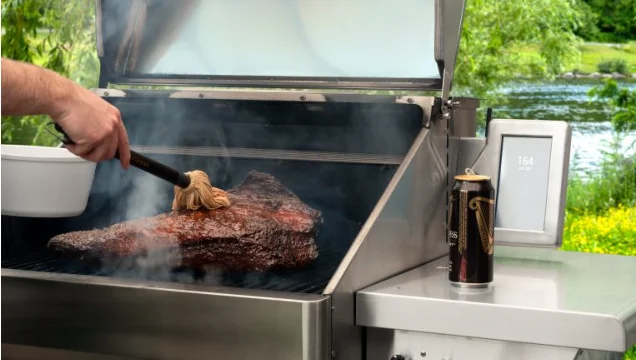Introduction
Smoking is an ancient culinary art that transforms simple ingredients into flavorful delights. Whether you’re a novice or an experienced smoker, mastering this cooking method can greatly enhance your culinary repertoire. Smoking involves slow-cooking food at low temperatures in a controlled, smoky environment. This process not only imparts unique flavors but also tenderizes meats, making them succulent and delicious. For those eager to dive into smoking, exploring various smoker recipes is a great start.
Understanding Your Smoker
Choose the Right Smoker
There are several types of smokers available, including electric, charcoal, and wood pellet smokers. Each type offers different features that may suit various cooking styles and preferences. Electric smokers are user-friendly and ideal for beginners, while charcoal smokers cater to those who prefer a more hands-on approach to control the intensity of the smoke flavor.
Know Your Wood Smoke Flavors
The choice of wood can significantly influence the taste of your smoked food. Woods like hickory and mesquite offer a strong flavor suitable for red meats, while apple and cherry wood provide a milder taste, perfect for chicken and fish. Experimenting with different woods can help you find the perfect match for each recipe.
Control the Temperature
Maintaining a consistent temperature is crucial in smoking. It ensures that the food cooks evenly and develops the desired smoke flavor. Most recipes require temperatures ranging from 225°F to 275°F. Using a digital thermometer can help monitor the smoker’s internal temperature without opening the lid frequently, which can cause fluctuations.
Prepare for a Long Cook
Smoking is a slow-cooking process. Some meats, like brisket or pork shoulder, may require several hours to achieve the perfect tenderness and flavor. Planning your cooking time accordingly and having patience during the process are key factors in successful smoking.
Simple Smoker Recipes to Try
Smoked Pork Shoulder Perfection
- Select the Right Cut: Choose a well-marbled pork shoulder for the best results.
- Prepare the Meat: Apply a dry rub of your choice and let it marinate overnight.
- Smoke It Slow: Maintain a smoker temperature around 225°F and cook the pork shoulder until it reaches an internal temperature of 195°F.
- Rest Before Serving: Let the meat rest for at least 30 minutes before slicing to retain its juices.
Delicious Smoked Brisket
- Trim the Fat: Trim the brisket leaving about a quarter inch of fat to keep it moist during cooking.
- Season Generously: Use a simple salt and pepper rub or get creative with spices like garlic powder and paprika.
- Smoke Low and Slow: Cook at 250°F until the brisket’s internal temperature reaches 200°F.
- Wrap It Up: Wrap the brisket in butcher paper once it reaches 165°F to preserve moisture and finish cooking.
Succulent Smoked Ribs
- Remove the Membrane: Start by removing the membrane on the back of the rib rack for better seasoning absorption.
- Apply Your Rub: Coat the ribs evenly with your chosen rub.
- Control the Smoke: Smoke the ribs at 225°F, and consider wrapping them in foil after a few hours to prevent drying out.
- Glaze and Finish: Apply a barbecue sauce glaze in the final hour of smoking for a sticky, caramelized exterior.
Flavorful Smoked Chicken
- Brine for Moisture: Brining the chicken before smoking helps keep it moist.
- Season Inside and Out: Season the cavity and skin with herbs and spices to enhance flavor.
- Smoke to Safe Temperature: Ensure the chicken is smoked until the internal temperature reaches 165°F.
- Let It Rest: Allow the chicken to rest before carving to redistribute the juices.
Enhancing Your Smoking Skills
Experiment with Recipes
The more you smoke, the better you’ll understand the nuances of how smoke interacts with different foods. Don’t be afraid to experiment with various rubs, marinades, and types of wood. Each variation can bring a new dimension to your favorite dishes.
Master the Heat
Learning how to control your smoker’s temperature and manage flare-ups can elevate your smoking technique. Practice makes perfect, and over time, you’ll find that maintaining the right temperature becomes second nature.
Serve with Style
Presentation is key in making your smoked dishes stand out. Serve them with complementary sides like coleslaw, cornbread, or a refreshing salad to enhance the overall dining experience.
FAQs
What is the best wood for smoking meat?
Hickory and mesquite are great for strong flavors suitable for red meats, while apple and cherry woods are ideal for lighter, sweeter smoke suitable for poultry and fish.
How long does it take to smoke a brisket?
Smoking a brisket typically takes about 1 to 1.5 hours per pound at 250°F, depending on the size and desired level of tenderness.
Can I smoke vegetables in a smoker?
Yes, vegetables can be smoked and gain a delightful flavor. Dense vegetables like potatoes, carrots, and peppers work best.
Do I need to soak wood chips before smoking?
Soaking wood chips isn’t necessary for all smokers, but it can help prevent them from burning too quickly, especially in charcoal smokers.
What’s the ideal temperature for smoking chicken?
Chicken should be smoked at a lower temperature, around 225°F to 250°F, until the internal temperature reaches 165°F for safety.
Conclusion
Mastering the art of smoking doesn’t happen overnight, but with patience and practice, you can enjoy a wide range of delicious, smoke-infused meals. By following these simple recipes and tips, you’ll not only impress your friends and family but also satisfy your culinary curiosity. So, fire up your smoker, and let the flavors unfold!

Melody Roth, a seasoned blog writer with a passion for the delectable world of food, specializes in crafting mouth-watering articles on favorites like pizza and burgers. With years of experience under her belt, Melody serves up stories as tantalizing as the dishes she describes, making her an invaluable voice in the culinary blogging realm.

